|
|
|
Sort Order |
|
|
|
Items / Page
|
|
|
|
|
|
|
| Srl | Item |
| 1 |
ID:
137259
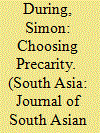

|
|
|
|
|
| Summary/Abstract |
This essay argues that global neo-liberalism has undercut the analytic power of the concept of the ‘subaltern’. It has instead produced a new category: the precariat. It makes this case first by examining Carlo Levi's Christ Stopped at Eboli, which helped define the subaltern, and then by showing that the aftermath of the 1968 revolutions slowly overturned the problematic installed by Levi and the Subaltern Studies group. It ends by offering an account of contemporary precarity via a reading of Amit Chaudhuri's novel, The Immortals.
|
|
|
|
|
|
|
|
|
|
|
|
|
|
|
|
| 2 |
ID:
137264
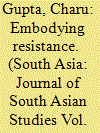

|
|
|
|
|
| Summary/Abstract |
Extending the paradigms of Subaltern Studies, this paper takes up three disparate sites—didactic Hindi literature, conversions and army discourses—to provide a perspective on the disjunctive forms of representation that signified Dalit bodies in colonial north India. Through different arenas, it shows how representations constituted, and were reflective of, the power relationships between upper and lower castes, in which the former reinstated their dominance. At the same time, the paper challenges straightjacketed links between representation and domination by expanding its archival arenas, and argues that Dalit bodies were not just screens on which high castes and colonial authorities projected their own caste, racial and gender anxieties. Rather, Dalits too represented themselves in different ways, conceiving a gendered sense of self in social, religious, public and political spaces. Such contested practices of representations produced creaks and dislocations in dominant embodiments.
|
|
|
|
|
|
|
|
|
|
|
|
|
|
|
|
| 3 |
ID:
137265
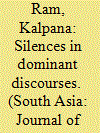

|
|
|
|
|
| Summary/Abstract |
Subaltern Studies continues to be generative for understanding the present, provided we expand our evaluation beyond the question of ‘who is subaltern?'. This paper considers instead underlying methodological orientations that outlive their original empirical context, lending themselves to fresh applications. The original method trained us to notice gaps in governmental discourse, silences that underlie its claims to know and administer all within its domain. Based on ethnographic work in rural south India, the paper argues that despite the radical expansion of governmental discourse, it still does not coincide with the everyday practices people continue to inhabit. These practices shape, for example, rural women's everyday poesis in the stories they tell of injustices they have suffered, and the way these injustices erupt as disorder in the body's relationship to the world. To be able to write about these silences minimally requires, however, a second orientation, also present in early Subaltern Studies. This is the underlying epistemic confidence that it is possible, despite the odds, to understand better the meanings and workings of practices that may no longer constitute coherent or self-sufficient worlds—but which nevertheless continue to enjoy a vital and lively presence for subalterns, and for us all.
|
|
|
|
|
|
|
|
|
|
|
|
|
|
|
|
| 4 |
ID:
137260
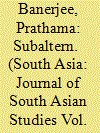

|
|
|
|
|
| Summary/Abstract |
The subaltern is a name that no one has claimed—it is neither identity nor ideality. That precisely has been the power of this invented category—giving it immense political flexibility, narrative agility and innate resistance to being reductively or instrumentally used. Is it this that makes the subaltern a purely political subject who is socially or culturally marked, but only contingently? But then, the subaltern has also leaned towards ‘being’ the peasant now, the poor then, the woman and the Dalit sometimes. Indeed, one asks today if she could be the refugee, the migrant, the post-humanist ‘human’, bare life. Is the subaltern then really the protagonist of history? Or is it history itself that is the subject here, setting up the subaltern as a front figure? This essay tries to think through these questions surrounding the subaltern as a category, caught as it is between being a political subject par excellence and being a historical character. In this essay, I revisit Subaltern Studies as a specific moment in the tradition of thinking about the political in South Asia.
|
|
|
|
|
|
|
|
|
|
|
|
|
|
|
|
| 5 |
ID:
137257
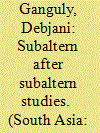

|
|
|
|
|
| Summary/Abstract |
Few scholars of my generation with an interest in South Asian and Post-Colonial Studies have escaped the influence of Subaltern Studies. Many of us chose a research trajectory that fortuitously offered opportunities to work in proximity with members of the Subaltern Studies collective. By the time I began my graduate work on caste and Dalit studies at the Australian National University (ANU) in Canberra in the late 1990s, Ranajit Guha had already stepped down as editor of Subaltern Studies and his celebrated six volumes had become part of global academic lore. Reading these volumes as a fresh college lecturer in Mumbai in the early 1990s played no small part in my decision to undertake my graduate training in Canberra. Guha, after all, was based at ANU as a senior research fellow at the erstwhile Research School of Pacific and Asian Studies (RSPAS). He had moved there in 1980 from the UK and lived in Canberra for the next two decades, in effect conferring on ANU the distinction of being the academic home from which the classic volumes of Subaltern Studies emanated—a fact, perhaps, little known to a new generation of post-colonial scholars globally. Dipesh Chakrabarty, an alumnus of ANU, had already moved to the University of Chicago. But he had a visiting appointment at the Humanities Research Centre that adjoined the Literature Department in ANU's famous A.D. Hope Building. Given my disciplinary base in the literature programme, I soon got to meet them both through formal introductions by the chair of my panel, Jon Mee.
|
|
|
|
|
|
|
|
|
|
|
|
|
|
|
|
| 6 |
ID:
137261
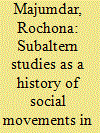

|
|
|
|
|
| Summary/Abstract |
While there is a thriving sociological and historical literature on social movements in post-colonial India, popular mobilisations of the colonial period are rarely addressed in terms of social movements. But the historical record is replete with instances of countless mobilisations seeking change against the state and other forms of authority in colonial society. This essay analyses a select group of works by the historical collective, Subaltern Studies, with the explicit goal of seeing these works as histories of social movements in colonial India. It also argues that one of the lasting legacies of the collective's writings was to present us with a paradigm, not unchallenged, of the revolutionary subject of such movements. By focusing in particular on Ranajit Guha's early writings, I present a reading of the colonial Indian peasant as this paradigmatic rebel subject.
|
|
|
|
|
|
|
|
|
|
|
|
|
|
|
|
| 7 |
ID:
137258
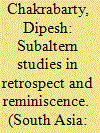

|
|
|
|
|
| Summary/Abstract |
This essay aims to provide a context for the intellectual project of ‘subaltern history’ and the associated series, Subaltern Studies, by undertaking a retrospective description and evaluation of the project and by drawing on the history of Dipesh Chakrabarty's personal involvement in it. It also attempts to outline some of the limitations of the original conception of the project as well as highlight some of its more enduring legacies.
|
|
|
|
|
|
|
|
|
|
|
|
|
|
|
|
| 8 |
ID:
137262
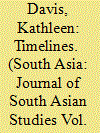

|
|
|
|
|
| Summary/Abstract |
This essay advances an argument regarding the structure of periodisation and the ways in which it limits critique of imperial historiography. It focuses first on the history and structure of medieval/modern periodisation and its relationship to the more recently popular ‘early modern’, and then turns briefly to the historiography of feudalism, an important anchor of the period concept, ‘the Middle Ages’. It then attends in more detail to the historiography of secularisation, particularly the recent tendency to find a secularising impulse in the texts of ‘early modern’ authors such as Vitoria and Grotius, which ultimately reinscribes the imperial logic that Subaltern Studies has worked to critique.
|
|
|
|
|
|
|
|
|
|
|
|
|
|
|
|
| 9 |
ID:
137263
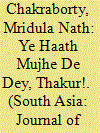

|
|
|
|
|
| Summary/Abstract |
This essay argues that the figure of the dacoit/daku in Bombay cinema functions as the subaltern who is interpellated by, and yet cannot be contained by, the strictures of ‘modern’ law in a newly-independent post-colonial state. Reminiscent of an older polity, where rural outlaw figures operated as rebels to the existing social order inflected by caste and gender, dacoits in popular Hindi films give voice to the peasant insurgent, dispossessed of his land by age-old caste-based, as well as new, forms of governance. Taking up three screen dacoit characters in Bombay cinema, Gabbar Singh from Sholay (1975), Phoolan Devi from Bandit Queen (1994) and Paan Singh Tomar from Paan Singh Tomar (2010), this paper argues that in its obsession with the representation of dakus, Bombay cinema betrays its anxiety about a post-colonial juridical order that continues with the oppressions of feudal and colonial hierarchies. Thus, Bombay cinema continues to rely on the subaltern as idea and concept in order to map the tension between a nationalist/statist history and a narrative of rebellion and resistance from below, particularly in caste terms. (The term ‘Ye haath mujhe de dey, Thakur!’, from Sholay, translates as ‘Give me these hands, Thakur!’).
|
|
|
|
|
|
|
|
|
|
|
|
|
|
|
|
|
|
|
|
|